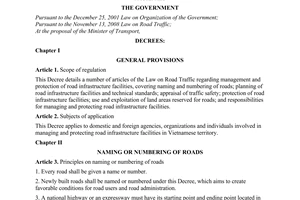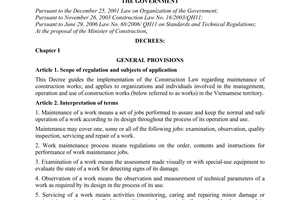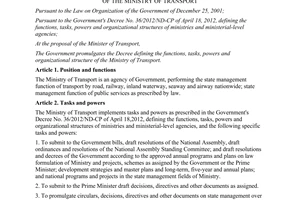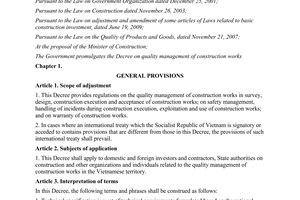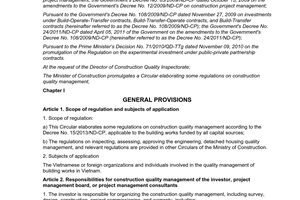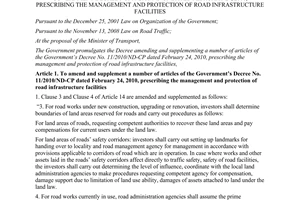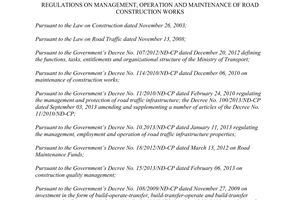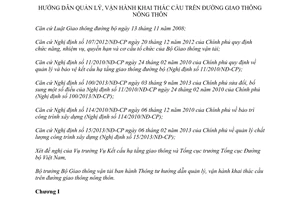Nội dung toàn văn Circular No. 12/2014/TT-BGTVT guidance on management and exploitation of bridges on rural roads
|
THE MINISTRY OF
TRANSPORT |
SOCIALIST
REPUBLIC OF VIETNAM |
|
No.: 12/2014/TT-BGTVT |
Hanoi, April 29, 2014 |
CIRCULAR
GUIDANCE ON MANAGEMENT AND EXPLOITATION OF BRIDGES ON RURAL ROADS
Pursuant to the Law on Road traffic dated November 13, 2008;
Pursuant to the Government’s Decree No. 107/2012/NĐ-CP dated December 20, 2012 defining the functions, tasks, entitlements and organizational structure of the Ministry of Transport;
Pursuant to the Government’s Decree No. 11/2010/NĐ-CP dated December 24 2012 defining management and protection of road traffic infrastructural structures (Decree No. 11/2010/NĐ-CP);
Pursuant to the Government’s Decree No. 100/2013/NĐ-CP dated September 03, 2013 amending and supplementing some articles of the Decree No. 11/2010/NĐ-CP dated February 24, 2010 (Decree No. 100/2013/NĐ-CP);
Pursuant to the Government’s Decree No. 114/2010/NĐ-CP dated December 06, 2010 on maintenance of construction works (Decree No. 114/2010/NĐ-CP);
Pursuant to the Government’s Decree No. 15/2013/NĐ-CP dated February 02, 2013 on construction quality control (Decree No. 15/2013/NĐ-CP);
At the proposal of General Director of Department of Transport Infrastructure and General Director of Directorate for Roads of Vietnam,
The Minister of Transport has promulgated the circular providing guidance on management and exploitation of bridges on rural roads.
Chapter I
GENERAL PROVISIONS
Article 1. Scope and regulated entities
1. Governing scope
a) This Circular provides guidance on management and exploitation of bridges on rural roads.
Maintenance of bridges on rural roads is executed according to the provisions set out in the Decree No. 114/2010/NĐ-CP the Circular No. 52/2013/TT-BGTVT dated December 12, 2013 of the Minister of Transport regulating management, exploitation and maintenance of road works (Circular No. 52/2013/TT-BGTVT);
b) As for bridges on the road system other than the scope as defined in Point a, Clause 1 of this Article, this Circular shall be referred to for management and exploitation as appropriate based on characteristics and scale of bridges.
2. Regulated entities
This Circular applies to organizations, individuals involved in management and exploitation of bridges on rural roads.
Article 2. Interpretation of terms
In this Circular, some terms are construed as follows:
1. Rural roads include communal roads, trans-commune roads, hamlet roads; roads going through villages and residential areas; intra-field roads.
2. Bridges on rural roads (hereinafter referred to as bridges) include suspension bridges, beam, truss, frame and arch bridges which are built on rural roads.
3. Road management agencies mean professional and management agencies affiliated to the Ministry of Transport; regulatory agencies under People’s Committee of central-affiliated provinces, cities (hereinafter referred to as People’s Committee of province-level), People’s Committee of provincial-affiliated districts, communes (hereinafter referred to as People’s Committee of district-level); the People’s Committee of communes, wards and towns (hereinafter referred to as the People’s Committee of commune-level).
4. Bridge managing owner means a common name for any organization assigned by regulatory agencies for management, exploitation and use of state-owned bridges; for owners of non-state owned bridges; for residential communities, organizations or individuals that contribute capital to the construction, management, exploitation and maintenance of bridges.
5. Bridge management and exploitation units (hereinafter referred to as the bridge management unit) mean organizations, individuals assigned by bridge managing owners for execution of contracts for management, exploitation and maintenance of bridges.
Article 3. General provisions on management and exploitation of bridges
1. Management and exploitation of bridges must ensure safety to traffic, bridge works, people, properties and other works within road safety corridor of bridges, fire prevention and environmental protection.
2. Bridges which are put into operation must ensure quality as regulated.
3. Every organization and individual shall be prohibited to:
a) Dismantle, assemble components of bridge works with discretion or commit any damaging acts to bridges and bridge roads; make inappropriate wording or drawings, erase, tamper with or obstruct visibility to bridge signs;
b) Invade, employ or violate road safety corridor within bridge range;
c) Violate regulations on loading, dimensional limits of bridges and permissible speed;
d) Violate instructions and regulations on bridge traffic;
dd) Use bridge deck, space underneath bridge, components of bridges and space of bridge roads;
e) Install or hang water supply and drainage pipelines, electricity and telecommunication cables on bridges except otherwise allowed by bridge design or permitted by bridge managing owners;
g) Violate the provisions of the Law on Road traffic and other relevant laws.
Article 4. Organizations, individuals responsible for management and exploitation of bridges
1. Identify bridge managing owners:
a) For state-owned bridges, the bridge managing owner shall be identified based on the regulations promulgated by People’s Committee of province-level on assignment and empowerment to People’s Committees at all levels, the Services of Transport and affiliated agencies for management and exploitation of bridges in the administrative division;
b) For any bridge owned by residential community, privately owned and non-state owned, owners shall be identified as the bridge managing owner.
In case residential community and private individuals are not capable of acting as a bridge owner, the agency that is assigned and empowered as regulated in Point a, Clause 1 of this Article shall execute rights and responsibilities of the bridge owner;
c) In case any bridge that is built from sources of capital contributed by residential community and the State, or supported by the State, sponsored by organizations, individuals, the capital contributing party shall unanimously choose a bridge owner.
2. Bridge managing owners shall be responsible to the law and senior-level agencies (if any) for management and exploitation of bridges according to the provisions of this Circular and other relevant laws.
3. Bridge managing owners may assign, empower or execute a contract with the bridge management unit for part or whole of the task of management and exploitation of bridges. In this case, bridge managing owners shall be responsible for any incident or degradation of bridges during the period of management and exploitation.
4. The bridge management unit shall be responsible to the bridge owner and to the law for management and exploitation of bridges according to the undertakings and the provisions hereof.
Chapter II
GUIDANCE ON ESTABLISHMENT, APPRAISAL, APPROVAL AND USE OF PROCEDURES FOR MANAGEMENT AND EXPLOITATION OF BRIDGES
Article 5. Bridges subject to the establishment of procedures for management and exploitation
1. Bridges under new construction, renovation, and upgrading as defined below shall be subject to the establishment and issuance of procedures for management and exploitation:
a) Suspension bridges with length of span being at least 70 meters; steel truss bridges, beam bridges with length of spans being at least 50 meters and bridge works from grade II and over as defined by the Circular 10/2013/TT-BXD dated July 25, 2013 of the Ministry of Construction detailing a number of articles about construction quality control (hereinafter referred to as the Circular No. 10/2013/TT-BXD);
b) Other cases as decided by investors or persons making decision about investment.
2. Bridges that are currently in exploitation and defined as follows shall be subject to the establishment and issuance of procedures for management and exploitation:
a) Bridges as defined in Point a, Clause 1 of this Article;
b) Other cases as decided by bridge managing owners.
3. Procedures for management and exploitation of bridges may be established separately or in company with procedures for bridge maintenance.
Article 6. Establishment, appraisal and approval of procedures for management and exploitation of bridges
1. Bridges under new construction, renovation, or upgrading:
a) Technical design consultants (for bridge works with three-step design), construction drawing design consultants (for bridge works with one- or three-step design) shall be responsible for establishment of procedures for management and exploitation of bridges.
In case the design consultant fail to establish the procedures, the Investor shall be responsible for selecting a substitute qualified and experienced for the job;
b) The Investor shall be responsible for appraising and approving the procedures for management and exploitation of bridges.
In case of necessity, the Investor shall hire consultants to verify the procedures for management and exploitation of bridges before approval is given. The verifying consultant shall be responsible for quality and content of the procedures verified by itself;
c) Equipment supplier (if any) shall be responsible for handing over the procedures for management and exploitation of equipment supplied by itself to the Investor.
2. Bridges already put into operation:
a) For bridges owned or contributed in capital by the State, the bridge managing owners shall establish, appraise and approve the procedures for management and exploitation according to the regulations by the People’s Committee of province-level;
b) Article 6. Establishment, appraisal and approval of procedures for management and exploitation of bridges;
c) The procedures for management and exploitation of bridges shall be established by the bridge owner itself or by a qualified and experienced consultant hired by the bridge owner.
3. If the People’s Committees of district-, commune-level, residential community are an investor or bridge owner, they should negotiate with the Services of Transport before approving the procedures for management and exploitation of bridges.
Article 7. Content of the procedures for management and exploitation of bridges
Content of the procedures for management and exploitation of bridges consists of:
1. General provisions, including:
a) Scope and regulated entities of the procedures;
b) Effect of the procedures;
c) Legislative documents promulgated by regulatory agencies concerning establishment of procedures for management and exploitation include the Law on Road traffic, governmental decrees detailing the implementation of the on Road traffic, Circular promulgated by the Minister of Transport and other legislative documents;
d) Technical regulations and standards on management and exploitation of bridges include technical regulations and standards applied to bridge design, main materials for bridge construction, standards and regulations on design of bridge roads and other regulations and standards;
dd) Reference documents;
e) Documents of bridge works made during the construction and as-built drawings shall serve as the documents serving the management and exploitation of bridges. The procedures must include general information about bridge range, components of bridges, bridge roads, road signs, embankment and anti-corrosion works (if any) and other works;
g) Other important matters
2. Tasks to be carried out since the bridge is put into operation
a) Take delivery of the bridge and put it into operation;
b) Determine scope of management and protection of bridges;
c) Establish, manage, use and store documents serving the management and exploitation of bridges;
d) Set up road signs and guide boards;
dd) Organize traffic
e) Make patrols and monitor bridge conditions;
g) Perform technical inspection of bridges
h) Carry out remedial works upon detection of any damage or defects during the patrol and technical inspection;
i) Handle any bridge showing signs of degradation and no safety for use; handle any incident caused;
k) Other important matters.
3. Other documents include tabular forms, appendices, forms, recording tape, photos and materials instructing management and exploitation of bridges.
4. Apart from the provisions as set out in Clauses 1, 2 and 3 of this Article, based on scale, nature and characteristics of each bridge and the provisions as set out in Chapter III hereof, any organization or individual who is responsible for the establishment, appraisal and approval must supplement necessary points to the procedures for management and exploitation of bridges to ensure safety and longevity of bridges.
Article 8. Use and adjustment of procedures for management and exploitation of a bridge while it (the bridge) is in exploitation
1. Procedures for management and exploitation after being issued shall be the documents used for serving the tasks of management and exploitation of bridges.
2. For any bridge that is not subject to the establishment of procedures for management and exploitation, the provisions set out in Chapter III hereof shall be applied for management and exploitation. Bridge managing owners must supplement necessary points to suit scale, nature, structure, life, natural and operational conditions of each bridge.
3. For any bridge with the procedures for management and exploitation being promulgated before the effective date of this Circular, the bridge owner shall rely on this Circular to adjust and supplement points necessary for the management and exploitation of bridges.
4. During the management and exploitation of bridges, if necessary, the bridge owner shall adjust and make supplements to the procedures and make submission for approval as stipulated in Articles 5 and 6 hereof.
Chapter III
MANAGEMENT AND EXPLOITATION OF BRIDGES
Article 9. Take delivery of a completed bridge and put it into operation
1. Before putting a bridge into operation, the Investor shall be responsible for:
a) Fulfilling procedures for investment & construction management as stipulated;
b) Setting up road signs and guide boards adequately, operating bridges and safety works according to the provisions as set out in Article 12 hereof.
c) Hand over to the bridge managing owner the documents as stipulated in Clause 1, Article 11 hereof;
d) Hand over to the bridge managing owner the piling system, landmarks for clearance, building lines of road safety corridor within bridge range.
2. Upon hand-over, the investor, construction contractor, construction supervising unit, relevant organizations, individuals and bridge managing owner shall check the followings:
a) Work items (structure of beam spans, truss, frame, arch, hangers, suspender cables, pylon, main cable anchor, deck, piers, abutments, bridge roads and other work items). Any defect or fault in quality that is found shall be immediately remedied to ensure new design to be handed over as stipulated;
b) Road signs, guide boards and traffic safety system as stipulated in Article 12 hereof.
3. After taking delivery of the bridge and putting it into operation, the bridge managing owner shall issue a written notice to the Services of Transport, the People’s Committee of district-, commune-level, authorities of village about the date of operation of the bridge, loadings, permissible speed, dimensional limits and other necessary matters.
4. During the period of maintenance, the investor and construction contractor shall be responsible for remedying any damage and defect, replace damaged components or work items, and perform obligations according to the Law on construction.
Article 10. Determine scope of management and protection of bridges
1. Items and components of bridge works:
a) Abutment, piers and other components of substructure;
b) Beams (or truss, frame, arch), deck, safety handrail, wheel stoppers and other components of superstructure;
c) Main cable pier, main cable, hanger, main cable anchor, cable for righting moment; turnbuckles, cable clips and other components of suspension bridges;
d) Road signs and other items of road signage system
2. Road bridges
3. Wall, embankment and other protection works (if any).
4. Land area intended for roads as stipulated by the Law on Road traffic, Decree No. 11/2010/NĐ-CP and Decree No. 100/2013/NĐ-CP.
5. Lighting system (if any)
Article 11. Establishment and storage of the documents of management and exploitation of bridges
1. At least 10 days before the bridge is put into operation, the investor shall hand over to the bridge managing owner the following documents:
a) The procedures for maintenance except the cases that are not subject to establishment of procedures as defined in Clause 4, Article 6 of the Decree No. 114/2010/NĐ-CP.
In case the standards of maintenance issued by regulatory agencies or applied to similar bridges are employed, the investor and design consultant must adjust and supplement some necessary points to suit the bridge works managed by themselves before hand-over is made to the bridge managing owner;
b) The procedures for management and exploitation of bridges must contain separate procedures as stipulated in Clause 1, Article 5 hereof.
c) Documentation of construction drawing design, as-built drawings, site clearance, road safety corridor marks within bridge range and other documents related to management and exploitation of bridges;
d) List of equipment, spare parts and reserve materials not yet installed or employed during the stage of investment and construction (if any);
dd) Documentation of traffic safety assessment and initial conditions of bridges (if any);
e) Elevation, coordinates and marks serving bridge observation (if any);
2. During the management and exploitation, the bridge managing owner and bridge management unit shall be responsible for establishing the following documents:
a) Daily log of bridge conditions;
b) Records of bridge;
c) Minutes, documents of technical inspection and assessment of bridge conditions;
d) Documents related to regular or un-regular remedial works, results of quality assessment and loading test (if any);
dd) Documents, minutes of handling violations of bridge works, road safety corridor within bridge range and bridge roads;
e) Documents related to traffic safety;
g) Figure of vehicle counts (if any);
h) Other relevant documents.
3. Any document and material as defined in Clauses 1, 2 of this Article shall be the documents used for serving the tasks of management and exploitation of bridges and be stored and protected by the bridge managing owner (except daily log of bridge conditions) and the bridge management unit.
4. Period for storage and protection of the documents is defined in the Law on storage but no later than the period for management and exploitation of bridges and life of bridge.
Article 12. Road signs, and guide boards for management and exploitation of bridges
When the bridge is put into operation, all road signs, guide boards and other safety measures must be set up. Particularly as follows :
1. For any bridge allowing passage of automobile, the following signs are set up:
a) “Name of bridge”;
b) “Restricted vehicular weight” or “Restricted axle load” in case restriction of weight-per-axle is regulated;
c) “Permissible maximum speed” (as the case maybe).
2. For any bridge allowing passage of non-motorized vehicle and pedestrians, the following signs "Name of bridge”, “Motor vehicles prohibited”, and “Livestock-drawn vehicles prohibited” must be set up.
3. For any bridge allowing passage of pedestrians only, signs as defined in Clause 2 of this Article and “Acts of pushing & pulling prohibited” sign must be set up.
4. Other appropriate road signs as regulated.
5. Guide boards for bridge traffic and regulations on management and exploitation of bridges must be set up at two ends of bridge. Some of the following information should be written on the guide board:
a) Traffic participants must comply with road signs;
b) For any bridge allowing passage of means of transport, such information as vehicular weight, speed and rear-end collision distance between vehicles traveling on bridge (if regulated) and regulations on stopping and turning on two ends of bridge must be written on guide boards;
c) Load and density of pedestrians per square meter of bridge deck, distances between pedestrians traveling on bridge;
d) Build-up of people prohibited;
dd) Violations of the provisions set out in Clause 3, Article 3 hereof prohibited;
e) Phone number of the bridge managing owner and bridge management unit;
g) For suspension bridges, such information as restricted traffic or bridge closed should be written on guide boards in case of storms, whirlwind or earthquakes;
h) Other instructions.
6. For areas with ethnic minority population and tourist places, in addition to road signs and guide boards in Vietnamese to be set up as regulated, the followings should be done:
a) Organize propaganda in minority languages about bridge traffic among ethnic minority population; instructions in minority language (if any) should be supplemented;
b) Instructions in English and foreign languages should be supplemented in tourist places if necessary.
7. Measures to limit clearance of vehicles if necessary.
Article 13. Traffic organization
1. People and vehicles participating in traffic must comply with the regulations of the Law on Road traffic, road signs and guide boards of bridges.
2. The bridge managing owner and bridge management unit shall be responsible for:
a) Instructing traffic participants to comply with the provisions set out in Clause 1 of this Article;
b) Organize propaganda about compliance with the regulations on bridge traffic and regulations on management and exploitation of bridges.
Article 14. Patrol and monitor bridge conditions
1. Bridge patrol and surveillance shall be executed by the bridge managing owner through the following manners:
a) The bridge managing owner shall carry out bridge patrol and surveillance itself.
b) The bridge managing owner may assign or execute a contract with the bridge management unit for part or whole of the task of bridge patrol and surveillance, supervise and inspect the tasks performed by the bridge management unit.
2. Task of bridge patrol and surveillance includes:
a) For bridges of beam span, truss, frame and arch structures, the task of bridge patrol and surveillance shall involve detection of damage (if any) caused to the following items: structure of beam span, truss, frame and arch, bridge deck, safety handrails, wheel stopper, water drainage pipes, bearing pad, expansion joints, abutments, piers and anti-corrosion works; bridge roads and drainage system at two ends of bridge, road signs, guide boards, safety works and other work items;
b) For suspension bridges, the task of bridge patrol and surveillances shall involve detection of damage (if any) caused to the following items: items as defined in Point a, Clause 2 of this Article; Main cable tower; connectors with abutment, piers; components of main cable, cable clips; anchor bolts, hanger, span structure, connectors with span structure, main cable anchor, turnbuckles, main cable bearing pad and other items; components of suspender cables, connectors between suspender cables and bridge deck; connectors between suspender cables and pylon, and other items.
3. Upon detection of any damage caused to the bridge works or construction parts, patrol force must carry out remedial works immediately to ensure traffic safety and at the same time report such damage to the bridge managing owner, People’s Committees at all levels, security force as stipulated hereof.
In case conditions for remedial works are not adequate, the provisions as set out in Articles 16 and 17 hereof shall be executed.
4. Upon detection of any sign of loss of traffic safety, the following tasks should be done:
a) Immediately execute measures to reduce vehicular weight; arrange appropriate distances between pedestrians or vehicles traveling on the bridge or apply measures to limit traffic to ensure safety;
b) Temporarily stop traffic on the bridge when signs of danger are detected and make immediate notice to People’s Committees of commune and the bridge managing owner for traffic directional distribution;
c) Other necessary tasks
5. Record bridge related information in the daily log; Such information includes:
a) Patrol time;
b) Patrol person;
c) Damage detected, remedial works and damage not remedied due to inadequate condition; proposals for conversion into regular or unregular maintenance and other necessary remedial works.
d) Violations overcome and not yet overcome; proposals for handling;
dd) Comments about traffic safety capability; proposals to competent agencies for handling difficulties. Daily log must be signed with full name by the patrol person after information is recorded.
Specimen daily log for bridge surveillance, refer to Appendix I enclosed herewith.
6. Number of bridge patrols, combination of patrols and maintenance:
a) Number of bridge patrols shall depend on conditions of each bridge but not less than once per week for any bridge that has been put into operation for less than five years; twice per week for any bridge that has been put into operation from five years and over; and once per day for all bridges during days of storm and flooding. Other cases as requested by the bridge managing owner or competent agencies when the bridge shows signs of degradation or loss of safety;
b) Bridge patrols shall be carried out independently or in combination with frequent maintenance.
Article 15. Technical inspection
1. Technical inspection involves visual inspection or use of special equipment to assess conditions of the works in order to detect signs of damage caused to the bridge.
2. Technical inspection includes one, some or all of the following tasks:
a) Carry out general inspection and assessment of separate components of suspension bridges, conditions of the main cable supporting tower; surface of main cable for defects, damage, for any sign of possible breakage or ooze of oil (with respect to oil cable); positions of main cable bearing pad; conditions of main cable anchorage for any sign of breakage of concrete or stone of anchorage; conditions of turnbuckles or cable pulley (if any), weld joints, anchor bolts for any sign of breakage; conditions of hangers and connectors between hangers and span structure and tower; positions of main cable clips; other necessary tasks;
b) For cable-stayed bridges, inspection is conducted according to the provisions set out in Point a, Clause 2 of this Article and conditions of suspender cable (tension and frequency of fluctuation);
c) Inspection of structure of beam span, truss, frame and arch
Inspection and assessment of conditions of beam, truss, frame and steel arch, reinforced concrete, building stone and wood beam by means of measurement, loading test and documentation of breaks and other tasks to assess loading capacity of beam, truss, frame and arch structures;
d) Inspection and assessment of erosion by flow on abutment, piers; surveillance of sinking, tilting or movement of footing, body and top of abutment, piers; inspection and surveillance of cracks in concrete, reinforced concrete or stone of abutment, piers;
dd) Inspection of other work items
3. Responsibilities for technical inspection
a) The bridge managing owner shall conduct technical inspection itself if being fully qualified. Otherwise the bridge managing owner must hire a qualified consultant to carry out regular inspection as stipulated in the Appendix II enclosed herewith;
b) For any bridge that gets damaged, downgraded or runs the risk of losing traffic safety in the administrative division and its source of investment capital is mostly unknown, regulatory agencies affiliated to People’s Committees of district-, commune-level must collaborate with the bridge managing owner on assessing exploitation of such bridge. In case traffic safety is lost, exploitation should be temporarily suspended for directional distribution.
4. When technical inspection is completed, any individual who takes part must establish a report with the following information:
a) Name of the bridge subject to inspection;
b) Date of inspection;
c) Name of organization, individual or specialist involved in inspection;
d) Results of inspection of work items;
dd) Comments about conditions of the bridge in current and previous inspections including size of cracks in concrete structure, movement of structures, deflection of beam, truss, frame and tower piers, main cable, tension of suspender cable;
e) Proposals for remedial works or others
Article 16. Remedial works to damage and defects that could not be remedied at the patrol and technical inspection step
1. Any damage or defect found impossible to be remedied at the patrol, surveillance and technical inspection step shall be planned for remedy and reported to the bridge managing owner.
2. The bridge managing owner shall be responsible for making a plan of regular and unregular remedial works according to the provisions of the Decree No. 114/2010/NĐ-CP and other relevant provisions.
Article 17. Handle a bridge showing signs of degradation and no safety for exploitation and handling of work incidents
1. Upon detection or receipt of a notice about a bridge showing signs of degradation or no safety for exploitation, the bridge managing owner shall immediately execute the following provisions:
a) Inspect and assess bridge quality;
b) In case the bridge is found dangerous, temporarily suspend the exploitation for protection at two ends of the bridge and organize directional distribution.
In case traffic restriction is necessary, take measures of setting up signs restricting vehicular weight, speed, distances, density and types of vehicles;
c) Communicate with traffic participants, residential community through mass media about temporary suspension of bridge exploitation or traffic restriction, provide guidance on participation in traffic and at the same time arrange people for bridge guard;
d) Make immediate report to People’s Committee of commune where the bridge is situated and senior-level agencies (if any);
dd) Report in writing to People’s Committee of district- and province-level within 24 hours. For bridge works of special grade, grade I and II that show signs of degradation and ensures no safety for exploitation or are likely to cause catastrophe in case of incident, make immediate report to the Ministry of Transport and the Ministry of Construction according to the provisions of law.
For works as defined in this Point, refer to the Appendix I of the Circular No. 10/2013/TT-BXD dated July 25, 2013 of the Minister of Construction detailing a number of articles about construction quality control ;
e) Remedy any damage likely to affect safety during operation of the bridge as stipulated in this Circular and relevant provisions;
g) Take protection measures to ensure safety and minimize the risk of collapse that may cause serious catastrosphe.
In case the bridge managing owner is not professionally qualified to take protection measures, it (the bridge managing owner) shall submit a written request to regulatory agencies and People’s Committees at all levels for instructions.
2. Upon receipt of the report or detection of signs of degradation that ensures no safety for exploitation and use, regulatory agencies shall be responsible for:
a) Inspecting, notifying and requesting the bridge managing owner to study, assess quality and level of danger, carry out remedial works or removal of work components and works if necessary;
b) Deciding to take measures as set out in Points a, b and c, Clause 1 of this Article if the bridge managing owner is not qualified to do the job;
c) Deciding to take measures as set out in Points a, b and c, Clause 1 of this Article if the bridge managing owner is not qualified to do the job;
3. Upon detection of incident or degradation of the bridge that imposes hazard on traffic safety, every organization or individual shall be responsible for making a written notice to the bridge managing owner, the bridge management unit, regulatory agencies, and authorities at all levels for timely handling as stipulated hereof.
4. Handling of incidents or risks of collapse of the works shall be done according to the provisions as set out in the Decree No. 15/2013/NĐ-CP and the provisions set out in Clause 3, Articles 30 and 31 of the Circular No. 10/2013/TT-BXD and the provisions of law.
Chapter IV
IMPLEMENTATION
Article 18. Responsibilities of the People’s Committee of province-level
1. Based on this Circular, promulgate provisions on assignment, empowerment and responsibilities for management and exploitation of bridge; regulate consideration and approval of the procedures for management and exploitation of bridge within scope of management.
2. Direct and examine People’s Committees at all levels, the Services of Transport and affiliated agencies to fulfill responsibilities for management and exploitation of bridge under this Circular.
3. Handle proposals made by People’s Committees at all levels, the Services of Transport and affiliated agencies on bridges that get damaged, downgrade and ensure no safety for exploitation in the administrative division.
Article 19. Responsibilities of the People’s Committee of district-level
1. Manage and exploit the bridges in the administrative as assigned, empowered by the People’s Committee of the province and the provisions of law.
2. Direct, examine and instruct the People’s Committees of communes, residential community and affiliated agencies to fulfill responsibilities for management and exploitation of bridge in the administrative division under this Circular.
3. Review the management and exploitation of bridge, the list of bridges that become damaged, downgraded and no longer safe for exploitation to prepare a report and proposals to the People’s Committee of the province and the Services of Transport for handling.
Article 20. Responsibilities of the People’s Committee of commune-level
1. Manage and exploit the bridges in the administrative division as assigned, empowered by the People’s Committee of senior level and the provisions of law.
2. Examine, instruct and speed up residential community to fulfill responsibilities for management and exploitation of bridges of their own under this Circular.
3. Review the management and exploitation of bridge, the list of bridges that become damaged, downgraded and no longer safe for exploitation to prepare a report and proposals to the People’s Committee of district-level for handling.
Article 21. Responsibilities of the Services of Transport
1. Act as an advisor for the People’s Committee of province-level in executing the provisions as set out in Article 18 hereof.
2. Instruct and examine within competence the execution of the provisions on management and exploitation of bridges in the administrative division.
3. Check and review the management and exploitation of all the bridges and the list of bridges that become damaged, downgraded and no longer safe for exploitation in the administrative division to prepare a report and proposals to the People’s Committee of province-level for handling.
Article 22. Responsibilities of residential community as owners of bridges
1. Organize management and exploitation of bridges of their own
2. Comply strictly with the instructions given by People’s committee and regulatory agencies at all levels in management and exploitation of bridges to ensure safety for traffic and bridge works and at the same time report difficulties during the management and exploitation of the bridge to People’s committee of commune-level.
3. Detect and prevent any act of damaging and encroaching on the bridge works and road safety corridor and other violations.
Article 23. Transitional provision
For any bridge that has been put into operation, the procedures for management and exploitation of bridge should be established as stipulated in Clause 2, Article 5 hereof and the bridge managing owner must complete the construction and promulgation of the procedures for management and exploitation of bridge on December 31, 2014 at the latest. While separate procedures are not yet promulgated, the management and exploitation of bridges shall be done in accordance with the provisions as set out in Chapter III hereof.
Article 24. Effect
This Circular shall take effect since June 15, 2014.
Article 25 . Implementation
The Chief of the Ministry Office, the Chief Inspector, general directors of the ministerial-affiliated departments, General Director of Vietnam Road Administration, heads of agencies, organizations affiliated to the Ministry of Transport, directors of the Services of Transport of central-affiliated provinces, cities, and relevant organizations and individuals shall be responsible for executing this Circular./.
|
|
THE MINISTER |
------------------------------------------------------------------------------------------------------
This translation is made by LawSoft and
for reference purposes only. Its copyright is owned by LawSoft
and protected under Clause 2, Article 14 of the Law on Intellectual Property.Your comments are always welcomed

